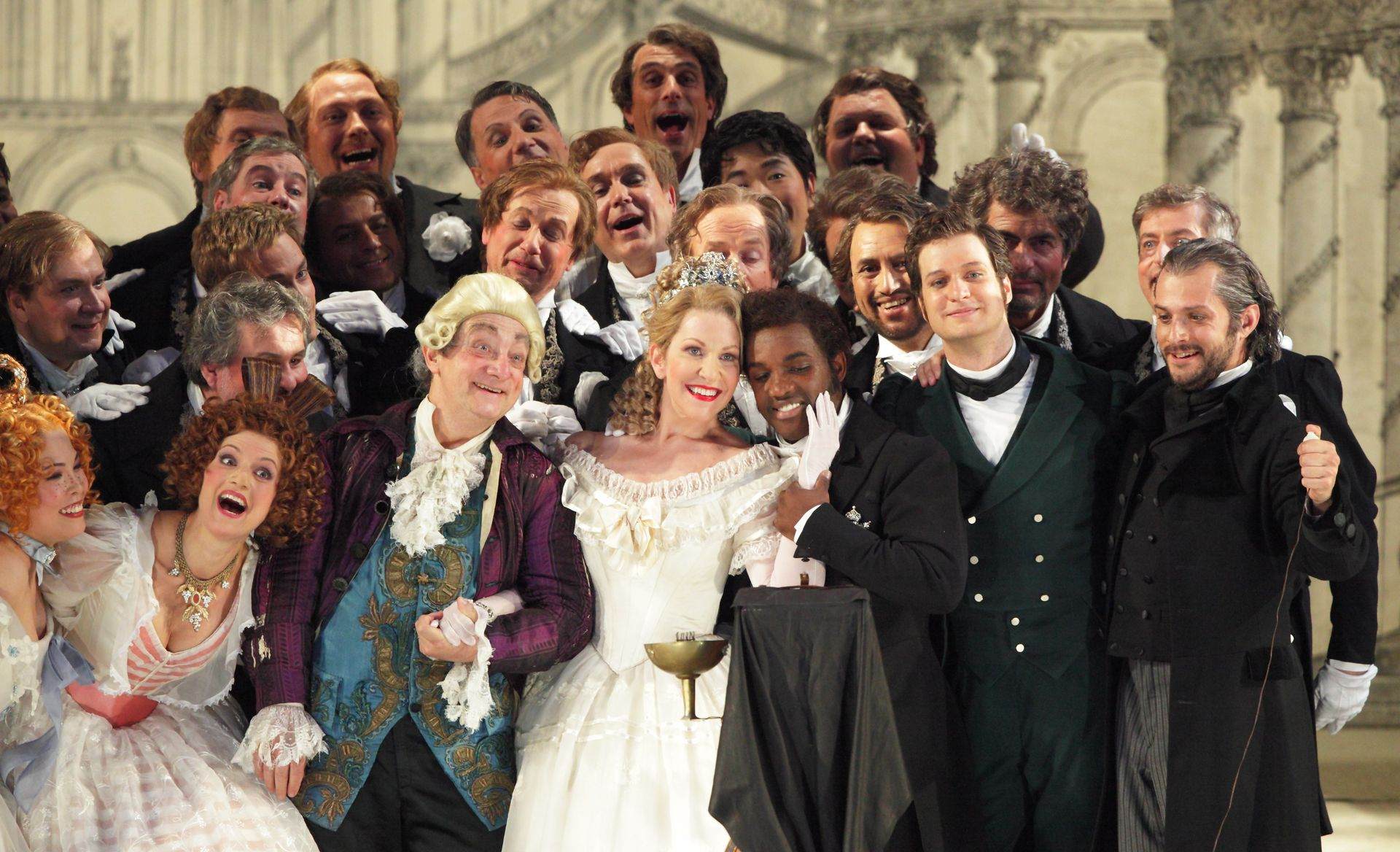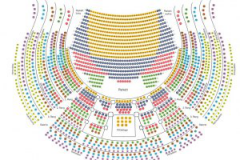La Cenerentola
Mo | Tu | We | Th | Fr | Sa | Su |
The story of Cinderella, her evil stepsisters, her malign stepfather and her eternal quest for happiness. It all begins with hassles and endless coloratura. But then: Prince Charming arrives! The legendary, effervescent production by Jean-Pierre Ponnelle is today a chapter of operatic history: a priceless legacy.
Act I
Don Magnifico's palace.
Introduction: "No, no, no, no: non v'è": Baron Don Magnifico lives here with his daughters Clorinda and Tisbe and his stepdaughter Angelina, known as Cenerentola (Cinderella). The stepfather has cheated her out of her entire fortune, and keeps her in the house as a scullery maid.
Alidoro, the tutor and confidant of the local Prince, Don Ramiro, is looking for a suitable bride of equal rank and station for his protégé. Disguised as a beggar, he discovers how generous Cenerentola is, and how heartless her two sisters are. Some noblemen arrive to tell them that the prince is entertaining thoughts of marriage, and they invite all the young ladies in the land to his castle.
Recitative and cavatina: "Miei rampolli feminini" The two sisters are madly excited over the invitation to the castle, as is their father. Don Magnifico is enchanted with the thought of seeing a secret dream come true and having one of his daughters marry the prince.
Scene and duet: "Un soave non so che in quegl' occhi scintillò" Don Ramiro, disguised as a servant falls in love with Cenerentola.
Chorus and cavatina: "Come un' ape ne' giorni d'aprile" The servant Dandini, disguised as the prince, appears, escorted by the noblemen, and while Don Magnifico looks on, he courts the Baron's two daughters.
Recitative and quintet: "Signor, una parola": Cenerentola begs Don Magnifico to allow her to go to the prince's ball, but he refuses. Don Magnifico tells Alidoro, who would like to meet all three daughters, that Cenerentola is just a lowly scullion, and his third daughter has died.
Recitative and aria: "Vasto teatro è il mondo": Alidoro comforts Cenerentola and promises to escort her to the ball.
Prince Don Ramiro's palace.
Recitative: "Ma bravo! Ma bravo!": Dandini, still disguised as the prince, appoints Don Magnifico chief wine steward.
Chorus and aria: "Intendente, reggitor" Don Magnifico performs the duties of his new office.
Duet and finale: "Zitto, zitto, piano, piano": Dandini reports to Ramiro how stupid the two sisters are. Unexpectedly Cenerentola appears, grandly attired. Everybody is struck by this beauty's remarkable similarity to Cenerentola. Banquet.
Act II
Prince Don Ramiro's palace.
Recitative and aria: "Sia qualunque delle figlie": Don Magnifico and his two daughters discuss their prospects: they are firmly convinced they will win the game.
Recitative and aria: "Si, ritrovarla io giuro": Cenerentola gives Don Ramiro a bracelet, and before disappearing she tells him look for her. Another bracelet, which she always wears, will enable him to recognize her.
Recitative and duet: "Un segreto d'importanza": Don Magnifico tries to get Dandini to tell him whether he has chosen Clorinda or Tisbe. Dandini, in response, reveals his true identity.
Don Magnifico's palace.
Song: "Una volta c'era un re": Cenerentola has returned to her usual place.
Recitative and thunderstorm: Don Magnifico and his two daughters return home in a fury.
Recitative and sextet: "Siete voi": Don Ramiro appears, this time clad in his princely raiment and escorted by Dandini. He recognizes the bracelet on Cenerentola's wrist. He wishes to make her his wife. Don Magnifico and his two daughters are beside themselves with anger.
Chorus, scene and rondo finale: "Nacqui all'affano, al pianto": The courtiers pay homage to their new princess, Cenerentola. Clorinda and Tisbe beg her forgiveness, which she generously grants. With everyone deeply moved, the curtain falls.
English translation by Donald Arthur
Program and cast
Conductor - Ivor Bolton
Production - Jean-Pierre Ponnelle
Set Design - Jean-Pierre Ponnelle
Choruses - Franz Obermair
Don Ramiro - Lawrence Brownlee
Dandini - Nikolay Borchev
Don Magnifico - Misha Kiria
Clorinda - Jessica Niles
Tisbe - Emily Sierra
Angelina (Cenerentola) - Isabel Leonard
Alidoro - Roberto Tagliavini
Bayerisches Staatsorchester
Chorus of the Bayerische Staatsoper
National Theatre Munich
The National Theatre Munich (German: Nationaltheater München) is an opera house in Max-Joseph-Platz in Munich, Germany. It is the home of the Bavarian State Opera and the Bayerisches Staatsballett(Bavarian State Ballet).
The Bavarian State Opera also performs in the Prinzregententheater, which opened in 1901 and, like the Bayreuth Festspielhaus, is built to Richard Wagner's specifications, and in the Cuvilliés Theatre at the Residenz, constructed in 1751–1753 and described by Thierry Beauvert as "a Rococo gem".
The Nationaltheater is very easy to get to both by car and by MVV public transportation.
By MVV public transportation
S-Bahn: S 1 - 8 Marienplatz
U-Bahn: U 3, 6 Marienplatz, U 3 - 6 Odeonsplatz
Bus: 52, 131 Marienplatz, 100 Odeonsplatz
Straßenbahn: 19 Nationaltheater
On the day of the performance, holders of regular tickets are entitled to use public transport provided by the Münchner Verkehrsverbund (MVV). This service starts at 3 pm respectively three hours before the performance commences and ends with the closing hour of the MVV.
By Car
Take the Altstadt-Ring to Maximilianstraße.
Parking garage Max-Joseph-Platz: open Monday to Sunday from 6:00 A.M. to 2:00 A.M.
You can take advantage of the special theatre parking fee of Euro 10,- from 6:00 P.M. to 8:00 A.M. by presenting your admission tickets.

 EN
EN DE
DE IT
IT FR
FR ES
ES RU
RU JP
JP RO
RO
 Seating plan
Seating plan 